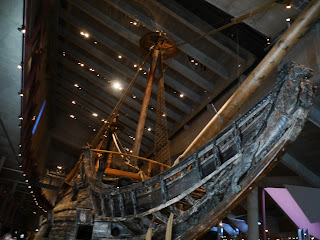 |
| Us on the commuter boat to the island with Vasa |
Vasa is a 17th century royal warship that set sail on August 10, 1628, and sank a couple of hours later along with 400 workers and family members only 200 meters into their trip. Thirty men and women drowned (trapped under cannons, they later figured out), the rest made it to shore. It took over 300 years for the boat to be found and brought back up to land to study even though they were only 1000 meters (3,300 feet) into their maiden voyage.

Timing was on our side. We showed up a couple of minutes before the film started in English, which then ended a couple of minutes before the guided tour (also in English) began. Sometimes things can go right.
With 64 guns, the Vasa was a heavily armed warship -- the best of its day. So why did it fail? The design was poor. It keeled too far allowing water to come in on the port side. It was too tall and not wide enough.
A month later a Council of State convened to lay the blame on someone, but they couldn't figure out who. Over the years they tried to find the boat and raise it, but it took until 1956 for a wreck expert to pinpoint exactly where it was, under 30 meters of water (about 100 feet).
Over the centuries other ships sank in the same general area. They identified this was the ship they were searching for when they found the royal arms on a cannon.
 Three years later everything was ready to try to lift it. First they had to plug in holes and patch the ship to make it safe to lift and float again.
Three years later everything was ready to try to lift it. First they had to plug in holes and patch the ship to make it safe to lift and float again.On May 24, 1961 they made international news by lifting the ship in front of television audiences globally. I can only imagine how big a deal it would be now in the era of social media.
Pumps drained the water to lighten the load. Archaeologists moved in to study this time capsule. Eventually they glided it to dock.
When the boat sank Gustov Adolf II was king.
When the boat was raised Gustov Adolf XI was king.
The boat is four stories high. It could fit 450 crew members and soldiers. It weighed 900 tons. Seventeenth century attempts to raise it failed due to technological issues.
For 17 years after it was lifted it was sprayed with polyurethane to replace the water in the woods. Four kilometers of roping was adding to re-rig the boat.
It is an archaeological treasure. The brackish water preserved the clothing, shoes, hair, and brains of the dead. They found 15 skeletons and could determine what they ate and any illnesses they had. No other ship of this age and site has been found so well preserved. The boat was not attacked by ship eating worms, nor had it suffered any battle damage.
The Vasa was designed to strike fear into the enemy upon site.
 |
| View inside the boat |
Alex, our tour guide, took us around the enormous boat, pointing out the ornate carvings and other features.
 |
| Replica of the boat |
 There was an exhibit about the women on board, which I found disappointing. There are only so many ways to say the wives of some of the sailors were on board.
There was an exhibit about the women on board, which I found disappointing. There are only so many ways to say the wives of some of the sailors were on board.After leaving Vasa we walked to our next destination: Skansen.


No comments:
Post a Comment